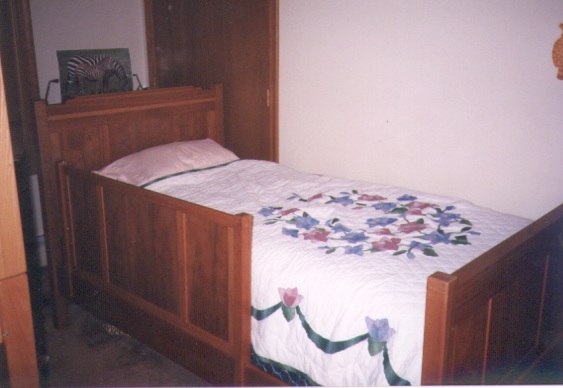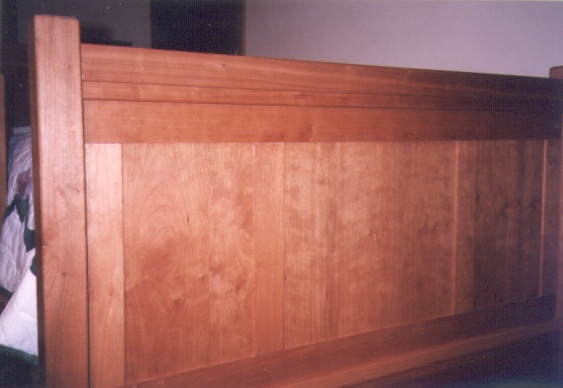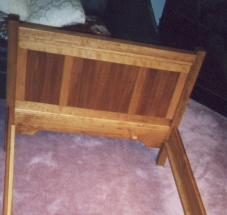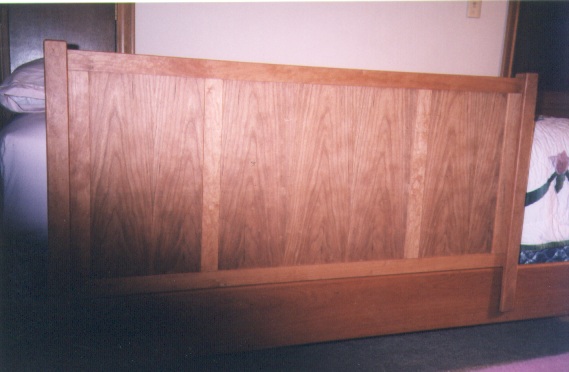|
Twin
Size Bed in Cherry
Almost 5
years ago, I built a set of bunk
beds for my kids. Recently, I finished another bed, this
time a single, stand-alone unit, in cherry. This bed shares
many similarities with the bunk beds, including the basic
dimensions (all use standard twin size mattresses) and the
rail attachment and mattress support structure. The main difference
lies in the height of the mattress used. The bunk beds used
a single mattress and bunky board to limit the overall height.
This bed uses a mattress and boxspring thus increasing the
height by some 6 to 7 inches. Accomodating this change meant
lowering the mounting height of the side rails and raising
the height of the headboard, footboards and bed guard.
This is
a brief description of the bed, with minimal information.
The goal is not to provide a play-by-play of the bed, but
rather to describe what it is so that the average woodworker
can get an idea of what was done. It is assumed that anyone
interested in reproducing a similar bed would have knowledge
on basic bed design and design something to his or her liking.
The above referenced bunk beds also offer information that
apply to this bed and provides a starting point for the novice
reader.
The
main rails on the bed are made from 4/4 rough cherry, planed
down until all four sides are parallel and smooth. The resulting
thickness is slightly over 3/4 inch while the width is about
6-1/4 inches. The length is 76 inches, just as with the bunk
beds. The same metal connectors are used to mount the rails
to the head/footboards as were used in the bunk beds. When
attached to the head/footboards, the bottom of the rails are
about 7-1/2 inches off the floor.
The
top side of the rails have a 1/4 inch roundover applied to
both the inside and the outside of the rail. It is necessary
to soften the rail's long edges since little feet will often
step on this edge. A 3/4 x 1 inch cleat is mounted along the
bottom inside edge of the rail which in turn supports four
3/4 inch thick stretchers spanning the width of the bed to
support the boxspring (these are not shown in the pictures
on this web page).

The bed is shown here with the guard. Each
of the four corner bedposts is roughly 2-1/8 inches square.
They measure 44 inches high on the headboard and 34 inched
high on the footboard. Their actual size was dictated by the
stock I had on hand. The span between (and not including)
the posts is 39 inches (as with the bunk beds). The bottom
of the main headboard structure is 18 inches off the ground
leaving a large gap to the floor. Since it was assumed that
the headboard will be placed against a wall thus hiding this
gap, a lower stretcher about 8 inches off the ground was added
to provide added stability. There are three plywood panels
in the middle of the headboard.

The very top has some decorative trim work
to differentiate the headboard from the footboard (aside from
height). There is no lower stretcher on the footboard, nor
is there any detail on the top edge.

There is however, some additional detail
on the lower edge as can be seen on this image. Pinned mortise
and tenon joinery is used throughout and care was taken to
account for wood movement. All posts edges are chamfered with
a hand plane and further softened with sandpaper.

Since this is a large bed in comparison
to the occupant, a bed guard was added. The guard resembles
the head/footboards in general appearance and slides onto
the main rails. The end posts on the guard are 25 inches high,
1-1/2 inches wide and 1-3/4 inches deep. Its overall width,
including the posts, is 46-1/8 inches. When installed, the
posts are 20-1/.4 inches above the rails. Note that the guard
is not strong enough to support large weights from above or
from the side. It will however keep a sleeping and tossing
child from falling down. When no longer needed, it will likely
be moved to the wall side of the bed.
All
surfaces were sanded to 400 grit, and finished with Danish
oil. A topcoat of wax finished the unit.
|